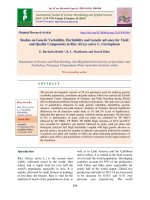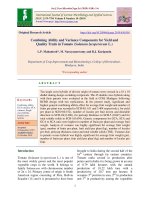Stability analysis for yield and its components in pigeonpea [Cajanus cajan (L.) Mill sp.] under rainfed conditions
Bạn đang xem bản rút gọn của tài liệu. Xem và tải ngay bản đầy đủ của tài liệu tại đây (276.16 KB, 11 trang )
Int.J.Curr.Microbiol.App.Sci (2017) 6(5): 1134-1144
International Journal of Current Microbiology and Applied Sciences
ISSN: 2319-7706 Volume 6 Number 5 (2017) pp. 1134-1144
Journal homepage:
Original Research Article
/>
Stability Analysis for Yield and its Components in
Pigeonpea [Cajanus cajan (L.) Mill sp.] Under Rainfed Conditions
Ramesh*, S. Muniswamy and B. Praveenkumar
Agricultural Research Station, Aland Road, Kalaburagi-585101 Karnataka, India
*Corresponding author
ABSTRACT
Keywords
Genotype x
Environment
(G x E),
pigeonpea,
stability.
Article Info
Accepted:
12 April 2017
Available Online:
10 May 2017
An Investigation was carried out to examine the stability analysis of the twenty genotypes
of pigeonpea including check BSMR-736, during kharif-2012, 2013 and 2014 under
rainfed condition at the Agricultural Research Station, Kalaburagi, Karnataka, India.
Highly significant differences among varieties were observed for all the characters except
pod bearing length (cm), number of pods per plant and seed yield kg/ha. The variance due
to Genotype x Environmental (GxE) interaction found significant for the characters like
number of seeds per pod and pod length. All the traits under the study except for 100 seed
weight showed significant differences in different environment. The variance due to
pooled deviation was highly significant for all the traits except primary branches, number
of seeds per pod and pod length under study which reflect considerable variability in the
material. Out of 20 genotypes the genotype ICP-13270 were found to be a stable for pod
length and ICP 9691 and ICP 12654 are on par with check for seed yield kg/ha across the
environments for rainfed conditions.
Introduction
Pigeonpea [Cajanus cajan (L.) Millsp.] is
commonly known in India, as redgram or
arhar or tur or thogari. It is a short-lived
perennial shrub in which plants may grow for
about five years and turn into small trees.
India is considered as the native of pigeonpea
(Vander and Messen, 1980) because of its
natural genetic variability available in the
local germplasm and the presence of its wild
relatives in the country.
This region is considered as a secondary
centre of diversity for pigeonpea, it is a short
lived perennial shrub in which plants may
grow for about five years and turn into small
trees. It is an often cross pollinated crop (20–
70 %) with diploid (2n=2x) chromosome
number of 22 and the estimated size of
pigeonpea
genome
packed
in
11
chromosomes is 858 Mbp (Greilhuber and
Obermayer, 1998).
It is an important grain legume that originated
in the Indian sub-continent. It is now grown in
many parts of the world including Southern
Africa particularly the region encompassing
Kenya, Mozambique, Malawi and Southern
Tanzania (Hogh Jensen et al., 2007).
Pigeonpea is the important grain legume
which occupies a major place in dietary
requirement. It is cultivated in varied agro
climatic conditions ranging from moisture
stress and input starved conditions to irrigated
conditions. Pigeonpea breeders look forward
1134
Int.J.Curr.Microbiol.App.Sci (2017) 6(5): 1134-1144
for widely adapted genotypes responsive to
input intensive as well as input deficient
agriculture in order to enhance production and
productivity of the crop. Selection and yield
testing are the two major phases of varietal
development and the later one is highly
influenced by the locations and years of
testing. The magnitude of G x E interaction
and its components has a direct bearing on the
environmental domain of the varieties to be
recommended for commercial cultivation.
With this back ground the present study was
undertaken under rainfed situation in three
locations to identify stable genotypes of
Pigeonpea for seed yield and its component
traits.
Materials and Methods
The present experiment material comprised of
20 genotypes of pigeonpea including check
BSMR-736 received from Indian Institute of
Pulse Research Kanpur. The trials were
conducted in a randomized block design with
two replications in three season viz., kharif2012, 2013 and 2014 grown under rainfed
condition. The plot size of two rows each with
4m length was followed with spacing of 75
cm between rows and 25 cm between the
plants observations were recorded on five
randomly selected plants in each replication
in each environment in respect of 12 different
metric characters viz., days to 50 per cent
flowering, days to maturity, plant height (cm),
number of primary branches per plant,
number of secondary branches per plant, pod
bearing length, number of seeds per pod, pod
length (cm), number of pods per plant, seed
yield per plant, 100- seed weight (g)and seed
yield kg/ha. Stability analysis was carried out
by using the stability model proposed by
Eberhart and Russell (1966).
Results and Discussion
Pooled ANOVA for stability of different
characters (Eberhart and Russell, 1966) are
given in table 1. Genotypic differences pooled
over environments were significant for the
nine characters except pod bearing length
(cm), number of pods per plant and seed yield
kg/ha. Variance due to environments was
significant for all the characters except 100
seed weight. Variance due to G × E was
significant for three characters viz., number of
seeds /pod and pod length (cm).However,
further
partitioning
of
genotype
x
environmental interaction as per Eberhart and
Russell’s (1966) model indicated that,
Environmental + (Genotype x Environment)
interaction was significant for plant height,
primary branches, number of seeds per pod,
pod length, seed yield per plant and seed yield
kg/ha. Environment linear component was
significant for all the traits except 100 seed
weight. Whereas, G × E (linear) interaction
was non-significant for most of the characters
except number of seeds per pod and pod
length (cm), which indicated differential
response of genotypes to the environments.
As regard to pooled deviation (nonlinear
portion of variance), which is unpredictable
portion of G × E interaction was significant
for all the characters except primary branches,
number of seeds per pod and pod length (cm)
under study. This demonstrated that
genotypes respond differently to variation in
environmental condition. The results are in
accordance with Shoran et al., (1981),
Balakrishna and Natarajratnam (1989) and
Sawargaokar et al., (2011). In contrast,
significant GxE (linear) for number of seeds
per pod and 100 seed weight was observed by
Muthiah and Kalaimagal (2005). Ghodke
(1992) obtained non significant G x E for
majority of the traits.
The genotype ICP 16309 showed minimum
number of days to 50% flowering (91.33
days) while, Bahar required maximum
number of days to 50% flowering (139.66
days) and population mean over three
environments was 117.65 days. All the
genotypes showed non-significant value for
1135
Int.J.Curr.Microbiol.App.Sci (2017) 6(5): 1134-1144
regression coefficient and deviation from
regression. The genotypes viz., ICP 16309,
ICP 14832, TJT 501, BSMR 736 (check), ICP
12654, ICP 6971, ICP 6049, TTB 7, RVK
284 and ICP 9691 were found to have lesser
mean value than population mean with non
significant bi and S2di values. None of the
genotypes had stable performance. ICP 16309
was the earliest to days to 50% flowering. The
genotypes which require minimum number of
days to 50% flowering are more desirable. So,
ICP 16309, ICP 14832, TJT 501, BSMR 736
(check) and RVK 284 had the regression
value more than unity, indicating its
suitability to favourable environments. The
genotypes viz., ICP 12654, ICP 6971, ICP
6049, TTB 7 and ICP 9691 had the regression
value less than unity, it indicates suitable for
poor environments. These findings are in
accordance with Patel et al., (2009),
Vannirajan (2007) who identified genotypes
with average responsiveness and also
genotypes with higher environmental
sensitivity.
The genotype ICP 16309 showed minimum
number of days to maturity (144.66 days)
while, Bahar required maximum number of
days to maturity (194.83 days) and population
mean over three environments was 173.13
days. All the genotypes showed nonsignificant value for regression coefficient
and deviation from regression. The genotypes
viz., ICP 16309, TJT 501,ICP 14832, ICP
6971, BSMR 736 (check), TTB 7, ICP 13270,
ICP 12654,ICP 13304, RVK 284 and ICP
6049 were found to have lesser mean value
than population mean with non significant bi
and S2di values. None of the genotypes had
stable performance. ICP 16309 was the
minimum number of days to maturity. The
genotypes which are early are more desirable.
So, ICP 16309, TJT 501, ICP 14832 and ICP
13270 had the regression value more than
unity, it indicates specifically adapted to
favourable environments. The genotypes viz.,
ICP 6971, BSMR 736 (check), TTB 7, ICP
12654, ICP 13304, RVK 284 and ICP 6049
had the regression value less than unity, it
indicates specifically adapted to unfavourable
environments. The results are in accordance
with Singh (1984) and Thanki et al., (2010)
identified genotypes having average and
above average stability for this trait.
Sreelakshmi et al., (2010) obtained three
stable genotypes (ICPL 98008, ICPHL 49792 and ICP 77303) for maturity.
The genotype ICP 8700 showed maximum
plant height (163.00 cm) while, ICP 16309
minimum plant height (113.33 cm) and
population mean over three environments was
143.43 cm. All the genotypes showed nonsignificant value for regression coefficient
and deviation from regression. The genotypes
viz., ICP 8700, NDA 1,TTB 7,ICP 13673,
Bahar, ICP 3451, ICP 9691, ICP 6668, ICP
13304,ICP 13270and RVK 284 were found to
have higher mean value than population mean
with non significant bi and S2di values. None
of the genotypes had stable performance. ICP
8700 was the highest plant height. The
genotypes which are tall plant height are more
desirable. So, ICP 8700, TTB 7, ICP 13673,
Bahar and ICP 3451 had the regression value
more than unity, it indicates specifically
adapted to favourable environments. The
genotypes viz., NDA 1, ICP 9691, ICP 6668,
ICP 13304, ICP 13270and RVK 284 had the
regression value less than unity, it indicates
specifically
adapted
to
unfavourable
environments. Similar results were obtained
by Sawargaokar et al., (2011), identified
stable genotypes for this trait. In contrast
Ghodke (1992) obtained non singnificant G x
E for this trait.
The genotype ICP 3451 showed maximum
number of primary branches (13.94) while,
ICP 16309 minimum numbers of primary
branches (8.88) and population mean over
three environments was 11.47. All the
genotypes showed non-significant value for
regression coefficient and deviation from
1136
Int.J.Curr.Microbiol.App.Sci (2017) 6(5): 1134-1144
regression. The genotypes viz., ICP 3451, ICP
12654, ICP 9691,NDA 1, MAL 13, ICP 8700,
ICP 13673, ICP 6049, ICP 6668 were found
to have higher mean value than population
mean with non significant bi and S2di values.
None of the genotypes had stable
performance. ICP 3451 was the higher
number of primary branches. The genotypes
viz., ICP 12654, ICP 9691, ICP 8700, ICP
6049, ICP 6668 and BSMR 736 (check) had
the regression value more than unity,
indicating its suitability to favourable
environments. The genotypes viz., ICP 3451,
NDA 1, MAL 13 and ICP 13673 had the
regression value less than unity, it indicates
suitable for poor environments.
The genotype ICP 6668 showed maximum
number of secondary branches (11.44) while,
ICP 13270 minimum numbers of secondary
branches (3.16) and population mean over
three environments was 6.52. All the
genotypes showed non-significant value for
regression coefficient and deviation from
regression. The genotypes viz., ICP 6668, ICP
6971, ICP 9691, ICP 12654, ICP 13673, ICP
3451, NDA 1, BSMR 736 (check) and ICP
13304 were found to have higher mean value
than population mean with non significant bi
and S2di values. None of the genotypes had
stable performance.
ICP 6668 found higher number of secondary
branches. The genotypes viz., ICP 6668, ICP
9691, ICP 12654, ICP 13673, BSMR 736
(check) and ICP 13304 had the regression
value more than unity, indicating its
suitability to favourable environments. The
genotypes viz., ICP 6971, ICP 3451 and NDA
1 had the regression value less than unity, it
indicates suitable for poor environments.
The genotype TJT 501 showed higher pod
bearing length (40.22) while, ICP 12654
lesser pod bearing length (24.83) and
population mean over three environments was
31.13. All the genotypes showed non-
significant value for regression coefficient
and deviation from regression. The genotypes
viz., TJT 501, RVK 284, ICP 8700, ICP
6049,ICP 14832, BSMR 736 (check), TTB 7,
ICP 16309 and ICP 3451 were found to have
higher mean value than population mean with
non significant bi and S2di values. None of the
genotypes had stable performance. TJT 501
found higher pod bearing length. The
genotypes viz., TJT 501, ICP 8700, ICP 6049
and ICP 3451 had the regression value more
than unity, indicating its suitability to
favourable environments. The genotypes viz.,
RVK 284, ICP 14832, BSMR 736 (check),
TTB 7 and ICP 16309 had the regression
value less than unity, it indicates suitable for
poor environments. These findings are in
accordance with Niranjan Kumar (2013).
The genotype ICP 13270 showed higher
number of seeds per pod (4.80) while, ICP
8700 lesser number of seeds /pod (3.66) and
population mean over three environments was
4.05. All the genotypes showed nonsignificant value for regression coefficient
and deviation from regression. The genotypes
viz., ICP 13270, ICP 13304, VKS 11/24-2,
NDA 1, RVK 284, MAL 13, BSMR 736
(check), TJT 501, Bahar and ICP 6668 were
found to have higher mean value than
population mean with non significant bi and
S2di values. The stability parameters for
number of seeds per pod exhibited the
genotypes RVK 284 and MAL 13 are stable
across
the
environments,
statistically
regression (bi) value is equal to unity and S2di
approaches to zero and ICP 13270 found
higher number of seeds per pod. The
genotypes viz., ICP 13304, VKS 11/24-2,
NDA 1, BSMR 736 (check), TJT 501 and
Bahar had the regression value more than
unity, indicating its suitability to favourable
environments. The genotypes viz., ICP 13270
and ICP 6668 had the regression value less
than unity, it indicates suitable for poor
environments.
1137
Int.J.Curr.Microbiol.App.Sci (2017) 6(5): 1134-1144
The genotype ICP 13270 showed highest pod
length (4.90) while, ICP 9691 less pod length
(3.82) and population mean over three
environments was 4.31. All the genotypes
showed non-significant value for regression
coefficient and deviation from regression. The
genotypes viz., ICP 13270, RVK 284, MAL
13, BSMR 736 (check), TTB 7, VKS 11/24-2,
NDA 1, ICP 14832, ICP 12654 and TJT 501
were found to have higher mean value than
population mean with non significant bi and
S2di values. The stability parameters for pod
length exhibited the genotype ICP 13270 as
stable across the environments, statistically
regression (bi) value is equal to unity and S2di
approaches to zero. and ICP 13270 found
maximum pod length. The genotypes viz.,
RVK 284, MAL 13, TTB 7, VKS 11/24-2 and
TJT 501 had the regression value more than
unity, indicating its suitability to favourable
environments. The genotypes viz., BSMR 736
(check), NDA 1, ICP 14832 and ICP 12654
had the regression value less than unity, it
indicates suitable for poor environments.
The genotype ICP 6668 showed higher
number of pods per plant (168.99) while, ICP
8700 lesser number of pods/plant (103.33)
and population mean over three environments
was 135.03. All the genotypes showed nonsignificant value for regression coefficient
and deviation from regression. The genotypes
viz., ICP 6668, ICP 9691, VKS 11/24-2,
BSMR 736 (check),ICP 13304, ICP 6049,
ICP 3451, TJT 501, ICP 12654 and TTB 7
were found to have higher mean value than
population mean with non significant bi and
S2di values. None of the genotypes had stable
performance. ICP 6668 found higher number
of pods per plant. The genotypes viz., ICP
6668, ICP 9691, ICP 13304, ICP 6049 and
ICP 3451 had the regression value more than
unity, indicating its suitability to favourable
environments. The genotypes viz., VKS
11/24-2, BSMR 736 (check), TJT 501, ICP
12654 and TTB 7 had the regression value
less than unity, it indicates suitable for poor
environments. These findings are in
accordance with Shoran et al., (1981);
Muthiah and Kalaimagal (2005); Vannirajan
et al., (2007); Patel et al., (2009); Sreelakshmi
et al., (2010); Thanki et al., (2010);
Sawargaonkar et al., (2011) and Niranjan
Kumar (2013)
The genotype ICP 6668 showed highest seed
yield per plant (40.31) while, ICP 14832 less
seed yield per plant (17.17) and population
mean over three environments was 29.20. All
the genotypes showed non-significant value
for regression coefficient and deviation from
regression. The genotypes viz., ICP 6668,
BSMR 736 (check), ICP 6971, VKS 11/24-2,
ICP 13304, ICP 13673, ICP 3451, ICP 9691
and NDA 1 were found to have higher mean
value than population mean with non
significant bi and S2di values. None of the
genotypes had stable performance. ICP 6668
found highest seed yield per plant. The
genotypes viz., ICP 6668, BSMR 736 (check),
ICP 6971, ICP 13304, ICP 13673, ICP 3451
and ICP 9691 had the regression value more
than unity, indicating its suitability to
favourable environments. The genotypes viz.,
VKS 11/24-2 and NDA 1 had the regression
value less than unity, it indicates suitable for
poor environments. These findings are in
accordance with Shoran et al., (1981);
Muthiah and Kalaimagal (2005); Vannirajan
et al., (2007); Patel et al., (2009); Sreelakshmi
et al., (2010); Thanki et al., (2010);
Sawargaonkar et al., (2011) and Niranjan
Kumar (2013).
The genotype TJT 501 showed highest 100
seed weight (10.60) while, ICP 13304 less
100 seed weight (7.46) and population mean
over three environments was 9.10.
1138
Int.J.Curr.Microbiol.App.Sci (2017) 6(5): 1134-1144
Table.1 Pooled MSS values for different quantitative traits over three environments
Source of
Variation
Rep within Env.
DF
DFF
DM
PHT
PB
SB
PBL
NSPP
PL
NPPP
YLDPPT
100SW
kg/ha
3
7.37
13.46
63.27
0.26
0.2
25.37
0.11 *
0.36 **
15.58
15.78
0.37
97103.81
Varieties
19
543.19 **
623.596 **
415.77 *
4.62 *
13.70 *
46.37
0.24 **
0.34 **
873.9
84.71 *
3.76 *
193454.3
Env.+ (Var.* Env.)
40
135.01
148.3
1602.90 **
4.77 **
10.48
127.1
0.37 **
0.62 **
1983.71
82.48 *
1.6
402206.60 *
Environments
2
723.45 **
605.706 *
27528.24 **
49.22**
66.27 **
1024.57 **
5.06 **
10.0 **
11589.02 **
780.14 **
1.15
Var.* Env.
38
104.04
124.22
238.4
2.43
7.5
79.84
0.12 **
0.12 *
1478.17
45.76
1.62
5159995.00
**
151796.7
Environments
(Lin.)
Var.* Env.(Lin.)
1
1446.91 **
1211.41 *
55056.45 **
98.44**
132.45 **
2049.1 **
10.1 **
20.1 **
23178.04**
1560.2 **
2.3
0319990.0 **
19
120.76
87.04
295.96
3.02
8.82
53.8
0.21 **
0.19**
1858.58
58.71
1.79
110851.6
Pooled Deviation
20
82.95 **
153.32 **
171.80 **
1.75
5.88 **
100.59 **
0.03
0.06
1042.86 **
31.17 **
1.38 **
83104.70 **
Pooled Error
57
2.38
2.96
16.64
1.35
1.03
9.23
0.06
0.06
27.06
5.39
0.08
15435.68
Total
59
266.44
301.35
1220.6
4.72
11.49
101.09
0.33
0.53
1626.31
83.2
2.29
334981.3
* & ** significant at 5% and 1% level respectively
DFF
DM
PHT
PB
SB
PBL
:
:
:
:
:
:
Days to 50 per cent flowering
Days to maturity
Plant height (cm)
Number of primary branches per plant
Number of secondary branches per plant
Pod bearing length
NSPP
PL
NPPP
YLDPPT
100SW
kg/ha
1139
:
:
:
:
:
:
Number of seeds per pod
Pod length (cm)
Number of pods per plant
Seed yield per plant
100- seed weight (g)
seed yield kg/ha
Int.J.Curr.Microbiol.App.Sci (2017) 6(5): 1134-1144
Table.2 Mean and stability parameters in 20 genotypes of pigeon pea
Traits
Genotypes
ICP 16309
VKS 11/24-2
ICP 6049
BAHAR
ICP 14832
ICP 6668
ICP 6971
ICP 13673
MAL 13
NDA 1
ICP 12654
ICP 13304
ICP 3451
ICP 13270
ICP 8700
RVK 284
TTB 7
ICP 9691
TJT 501
BSMR 736 (check)
Population Mean
Days to 50% flowering
Mean
bi
S2di
91.333 1.88
1.54
117.833 -1.6 352.91
115
-0.5
-2.41
139.667 -0.39 163.57
92.833 3.03
7.75
120.333 2.1 222.61
111
-0.04 306.78
131.833 1.1 138.03
131.667 1.15
89.95
126.5
1.98
8.12
109.333 0.2
65.58
121.833 2.94
14.56
127.5
-0.2
12.88
126.833 1.56
83.96
134.667 0.13
8.88
117.167 1.69
64.79
115.833 0.78
69.65
117.167 -0.3
-1.9
95.833 2.69
-1.72
109
1.79
0.93
117.658
Days to maturity
Mean
Bi
S2di
144.7
1.12 33.05
173.5
2.99 567.29
170.2
-0.24
0.16
194.8
0.9 347.66
159.7
1.22 22.17
180.3
1.99
5.19
161.7
-1.4 105.25
192.7
0.9 107.68
189
1.61 273.63
185.3
2.92
-2.83
169.5
-0.22 13.04
169.7
0.83 201.59
187.8
1.89 452.94
169.2
1.89 52.52
193.8
-0.49 34.42
170
0.77
-1.41
165.7
0.19 92.48
173.2
-0.03 -1.37
146.7
2.84 524.57
165.3
0.32 168.83
173.1
1140
Plant height (cm)
Mean
bi
S2di
113.33
1.1 481.19
141.83
1.5
-15.94
141.72
1.28 235.79
151.44
1.15 -16.59
127.17
0.17 795.84
147.5
0.91 -17.15
134.61
0.67 -18.95
153.22
0.76 -17.64
143.11
0.87
-4.4
161.11
0.73 -10.16
129.95
0.81 59.43
146.94
0.84 -14.14
150.28
1.16 606.39
144.93
0.68 314.91
163
1.11
7.1
144.17
0.96 301.66
154.5
1.55 18.45
147.84
1.33 61.39
133.61
1.06 36.13
138.45
1.35 253.18
143.44
Primary branches
Mean
bi
S2di
8.887
0.9
-1.15
10.5
1.31
-1.29
11.777 1.77
3.17
10.877 0.18
-1.13
11
0.19
0.26
11.722 1.23
-1.24
11.388 1.19
-0.8
12.055 -0.36
3.43
12.555 0.48
-1.26
12.888
0.9
2.79
13.165 2.26
0.68
10.888 1.72
0.01
13.943 0.35
-0.1
10.557 -0.07
0.36
12.227
1.3
1.57
10.33
1.44
1.27
10.375 2.17
2.86
13.108 1.53
-1.17
10.612 -0.17
-0.85
10.612 1.69
1.74
11.473
Int.J.Curr.Microbiol.App.Sci (2017) 6(5): 1134-1144
Table.3 Mean and stability parameters in 20 genotypes of pigeon pea
Traits
Genotypes
ICP 16309
VKS 11/24-2
ICP 6049
BAHAR
ICP 14832
ICP 6668
ICP 6971
ICP 13673
MAL 13
NDA 1
ICP 12654
ICP 13304
ICP 3451
ICP 13270
ICP 8700
RVK 284
TTB 7
ICP 9691
TJT 501
BSMR 736 (check)
Population Mean
Secondary Branches
Mean
5.872
6.365
5.222
4.637
4
11.443
10.005
7.72
5.855
7.397
8.222
7.253
7.555
3.168
5.198
5.015
4.298
9.222
4.763
7.315
6.526
bi
1.01
1.97
1.77
-0.54
0.31
2.05
-1.59
1.92
1.8
0.26
2.37
2.19
-0.36
-0.31
0.64
0.31
0.91
2.4
0.65
2.21
S2di
-0.95
-0.74
-0.98
0.1
-0.75
7.26
-0.95
0.58
-0.19
-0.77
36.19
23.15
3.57
1.05
3.6
5.94
0.07
-0.79
23.44
-0.97
Pod bearing length
(cm)
Mean
Bi
S2di
31.89
0.55 131.83
28.223
1.8
30.54
35.333 1.18
1.03
30
1.27
-7.87
33.472
-0.2
78.72
26.428 1.27
9.49
26.39
-0.34 -9.46
26.61
1.16 106.48
28.665 2.28
62.78
30.888
0.8
6.48
24.833 0.85 132.65
30.498
0.3
179.69
31.798 1.28 170.93
28.61
1.15 194.13
36.055 2.53
34.42
36.723 0.31 495.39
32.5
0.81
33.01
30.938 1.48
79.49
40.222
1.1
90.5
32.588 0.45
-9.19
31.133
1141
Number of seeds /pod
Mean
3.807
4.333
3.835
4.11
3.972
4.083
3.748
4.002
4.223
4.277
3.75
4.36
3.723
4.805
3.667
4.223
4.055
3.777
4.193
4.197
4.057
bi
-0.1
1.44
0.25
1.13
0.53
0.28
1.16
0.57
1.07
1.56
1.22
2.92
1.07
0.27
0.57
1.07
1.12
1.31
1.28
1.28
S2di
-0.07
-0.06
-0.04
0.18
-0.04
-0.07
-0.07
-0.06
-0.07
-0.06
-0.02
0.07
-0.07
0.04
-0.06
-0.07
-0.02
-0.03
-0.06
-0.06
Pod length (cm)
Mean
4.002
4.55
3.933
4.28
4.402
4.117
3.945
4.305
4.692
4.54
4.365
4.295
3.917
4.907
3.862
4.867
4.56
3.827
4.343
4.677
4.319
bi
1.21
1.48
0.93
1.16
0.7
1.37
0.95
1.4
1.25
0.67
0.45
-0.2
0.92
1.1
0.87
1.45
1.47
0.62
1.44
0.83
S2di
0
-0.07
-0.03
-0.07
-0.07
-0.07
-0.08
-0.06
-0.07
0.01
-0.08
-0.05
-0.08
-0.07
0.06
0.02
0.4
0.02
-0.08
-0.07
Int.J.Curr.Microbiol.App.Sci (2017) 6(5): 1134-1144
Table.4 Mean and stability parameters in 20 genotypes of pigeon pea
Traits
Genotypes
ICP 16309
VKS 11/24-2
Number of pods/plant
KG/HA
Seed yield per plant(g)
Mean
bi
S2di
Mean
bi
S2di
Mean
Bi
S2di
-2.45
8.617
6.06
-0.09
846.108
0.5
-219104
Mean
bi
S2di
125.667
1.03
128.56
27.427
1.42
100 seed weight (g)
152.5
0.78
-10.51
35.265
1.06
9.55
10.54
-0.1
0.13
1347.218
1.59
625894
ICP 6049
145.682
1.03
215.18
24.247
1.34
-5.15
8.343
5.28
3.34
1122.218
0.9
-13418
BAHAR
110.112
-0.25
369.75
26.555
0.93
2.31
10.537
-4.54
3.23
1198.883
1.16
-9949
ICP 14832
124
-0.45
9.18
17.173
-0.25
2.77
8.012
5.38
0.4
1099.997
0.86
569829
ICP 6668
168.998
4.29
420.95
40.312
3.59
12.16
7.965
-2.59
0.1
1520.272
0.85
1361830
ICP 6971
134.722
1.46
278.01
35.75
1.21
65.26
8.333
1.61
0.2
1456.105
0.66
-11266
ICP 13673
120.61
1.98
-18.07
32.323
1.51
-2.58
10.342
-4.79
2.4
1198.327
1.08
-2276
MAL 13
115.525
1.81
1616.88
25.61
1.51
21.38
10.363
-5.43
6.19
1101.662
0.92
-17963
NDA 1
126.795
0.23
3391.06
29.742
0.03
-5.64
9.468
-2.28
0.8
1048.883
0.37
53628
ICP 12654
142.617
0.41
4055.86
28.082
0.41
0.33
8.697
7.15
0.13
1729.99
2.02
109163
ICP 13304
148.71
2.94
21.03
33.612
0.84
20.58
7.46
1.22
0.06
1151.103
0.78
43686
ICP 3451
143.183
1.28
81555.6
30.473
1.13
24.27
7.682
1.07
-0.04
1162.775
-0.1
309247
ICP 13270
129
0.59
93126.96
24.445
1.78
186.32
9.425
1.07
1.26
1502.773
1.03
43234
ICP 8700
103.333
1.95
203.99
25.167
-0.38
46.14
8.358
2.1
5.22
1325.55
1.52
114592
RVK 284
119.943
-0.62
78.36
28.223
0.18
4.78
10.08
6.02
-0.08
1495.548
0.96
-5536
TTB 7
136.182
0.71
74.57
28.615
0.93
6.06
9.99
-1.76
-0.05
1287.218
0.94
16185
ICP 9691
158.445
1.57
84.53
30.038
1.33
3.44
7.505
5.36
1.19
1756.103
1.3
88620
TJT 501
142.782
-1.23
34695.81
24.8
0.27
111.76
10.605
-2.2
1.15
1168.883
1
26497
BSMR 736 (check)
151.945
0.5
29.9
36.165
1.17
3.89
9.78
1.34
0.16
1771.66
1.59
-11179
Population Mean
135.038
29.201
9.105
1142
1314.564
Int.J.Curr.Microbiol.App.Sci (2017) 6(5): 1134-1144
All the genotypes showed non-significant
value for regression coefficient and deviation
from regression. The genotypes viz., TJT 501,
VKS 11/24-2, BAHAR, MAL 13, ICP
13673,RVK 284, TTB 7, BSMR 736 (check),
NDA 1 and ICP 13270 were found to have
higher mean value than population mean with
non significant bi and S2di values. None of the
genotypes had stable performance. TJT 501
found highest 100 seed weight. The genotypes
viz., RVK 284, BSMR 736 (check) and ICP
13270 had the regression value more than
unity, indicating its suitability to favourable
environments. The genotypes viz., TJT 501,
VKS 11/24-2, BAHAR, MAL 13, ICP
13673,TTB 7 and NDA 1 had the regression
value less than unity, it indicates suitable for
poor environments.
The genotype BSMR 736 (check) showed
highest seed yield kg/ha (1771.66 kg) while,
ICP 16309 less seed yield kg/ha (846.10) and
population mean over three environments was
1314.56 kg. All the genotypes showed nonsignificant value for regression coefficient
and deviation from regression. The genotypes
viz., BSMR 736 (check), ICP 9691, ICP
12654, ICP 6668, ICP 13270, RVK 284, ICP
6971, VKS 11/24-2 and ICP 8700 were found
to have higher mean value than population
mean with non significant bi and S2di values.
The genotype ICP 13270 Well adapted to all
the environments and none of the genotypes
had stable performance. BSMR 736 (check)
found highest seed yield kg/ha. The genotypes
viz., BSMR 736 (check), ICP 9691, ICP
12654, VKS 11/24-2 and ICP 8700 had the
regression value more than unity, indicating
its suitability to favourable environments. The
genotypes viz., ICP 6668, RVK 284 and ICP
6971 had the regression value less than unity,
it indicates suitable for poor environments.
These findings are in accordance with Shoran
et al., (1981); Muthiah and Kalaimagal
(2005); Vannirajan et al., (2007); Patel et al.,
(2009); Sreelakshmi et al., (2010); Thanki et
al., (2010); Sawargaonkar et al., (2011) and
Niranjan Kumar (2013).
In conclusion, from the present study it can be
concluded that the genotype ICP-13270 were
found to be a stable for pod length, ICP 9691
and ICP 12654 are on par with check for seed
yield kg/ha across the environments for
rainfed conditions and these genotypes can
also be used as a donor parent for generating
new breeding material for development of
variety (Tables 1-4). However, this needs to
be verified by testing the breeding lines over
the season and over the locations for one
more year under rain fed condition.
Acknowledgements
The authors thank the Indian institute of pulse
research (IIPR) Kanpur for the financial
support.
References
Allard, R.W. and Bradshaw, A.D. 1964.
Implication
of
genotype
x
environmental interaction in applied
plant breeding. Crop Sci., 4: 503-505.
Balakrishnan, K. and Natarajaratnam, N.
1989.
Genotype-environment
interaction for yield components in
pigeonpea [Cajanus cajan(L.) Millsp.]
Madras Agri. J., 76: 365-370.
Eberhart, S.A. and Russell, W.A. 1966.
Stability parameters for comparing
varieties. Crop Sci., 6: 36–40.
Finlay, K.W. and Wilkinson, G.N. 1963.
Analysis of adaptation in plant breeding
programme. Australian J. Agri. Res.,
14: 742-754.
Ghodke, M.K., Jahagirdar, J.E. and Makne,
V.G. 1992. Phenotypic stability of
newly developed pigeonpea genotypes.
Indian J. Pulses Res., 5(2): 125-127.
Greilhuber, J. and Obermayer, R. 1998.
Genome size variation in Cajanus cajan
Fabaceae: a reconsideration. Plant Sys.
1143
Int.J.Curr.Microbiol.App.Sci (2017) 6(5): 1134-1144
Evol., 212: 135–141.
Hogh-jensen, H., Myaka, F.A., Sakala, W.D.,
Kamalongo, D., Ngwira, A., Vesterager,
J.M., Odgaard, R and Adu-gyamfi, J.J.
2007. Yields and qualities of Pigeonpea
varieties grown under smallholder
farmers’ conditions in eastern and
southern Africa. African J. Agri. Res.,
2: 269-278.
Muthiah, A.R. and Kalaimagal, T. 2005.
Stability analysis in hybrid pigeonpea.
Indian J. Pulses Res., 18(1): 76-79.
Niranjanakumara, B. 2013. Stability analysis
for yield and its attributing traits in
advanced genotypes of pigeonpea
[Cajanus cajana. (L) Millsp.]M. Sc.
(Agri.) Thesis, UAS Raichur Karnataka
India.
Patel, P.T., Chauhan, R.M., Parmar, L.D and
Tikka, S.B.S. 2009. Phenotypic stability
of yield and related traits in pigeonpea.
Leg. Res., 32(4): 235-239.
Sawargaonkar, S.L., Saxena, K.B., Madrap,
I.A. and Rathore, A. 2011. Stability
analysis of yield and related traits in
pigeonpea hybrids. J. Food Leg., 24(3):
184-193.
Shoran, J.B., Pandya, B.P. and Gautam, P.L.
1981. Genotype × environment
interaction analysis in pigeonpea. Crop
Impr., 8: 33-36.
Singh, V. 1984. Mechanical diallel and
stability analysis in pigeonpea [Cajanus
cajan (L.) Millsp.].M.Sc. (Agri.) Thesis,
Haryana Agricultural UniversityHissar
India.
Sreelakshmi, C., Sameer Kumar, C.V. and
Shivani, D. 2010. Genetic analysis of
yield and its component traits in drought
tolerant genotypes of Pigeonpea
(Cajanus cajan (L.) Millsp.). Elec. J. Pl.
Breeding, 1(6): 1488-1491.
Thanki, H.P., Sawargaonkar, S.L. and Hudge,
B.V. 2010. Genotype x environment
interaction for biometrical traits in
pigeonpea (Cajanus cajanL. Millsp.)
under varying spacing. Elec. J. Pl.
Breeding, 1(4): 925-928.
Van der and Messen, L.J.G. 1980. India is the
native home of the pigeonpea. In:
Arends JC BoelmaGde Grant CT
Leeuwaenberg
AJM.
(Eds)
Libergratularious in Honrem HCD.de
Wit. Agricultural University Miscellan
Paper, 19: 257-262.
Vanniarajan, C., Rangasamy, P. and
Nepolean, T. 2007. Stable and unstable
Pigeonpea genotypes for yield versus
component characters. Pl. Arch., 7(1):
427-428.
How to cite this article:
Ramesh, S. Muniswamy and Praveenkumar, B. 2017. Stability Analysis for Yield and its
Components in Pigeonpea [Cajanus cajan (L.) Mill sp.] Under Rainfed Conditions.
Int.J.Curr.Microbiol.App.Sci. 6(5): 1134-1144. doi: />
1144
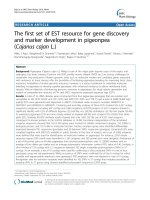
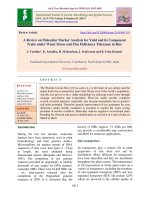

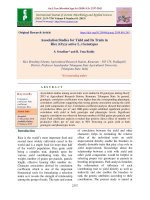
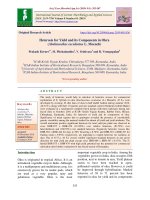
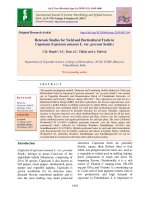
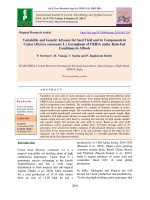
![Effect of conventional and nano micronutrient fertilizers on yield and economics of pigeonpea [Cajanus cajan (L.) Mill sp.]](https://media.store123doc.com/images/document/2020_03/02/medium_mml1583124760.jpg)
